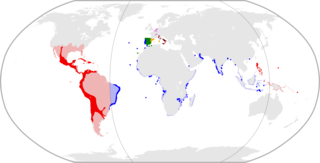 W
WThe Captaincy General of the Philippines, was an administrative district of the Spanish Empire in Southeast Asia governed by a Governor-General. The Captaincy General encompassed the Spanish East Indies, which included among others the Philippine Islands and the Caroline Islands. It was founded in 1565 with the first permanent Spanish settlements.
 W
WThe Council of the Indies; officially, the Royal and Supreme Council of the Indies, was the most important administrative organ of the Spanish Empire for the Americas and the Philippines. The crown held absolute power over the Indies and the Council of the Indies was the administrative and advisory body for those overseas realms. It was established in 1524 by Charles V to administer "the Indies," Spain's name for its territories. Such an administrative entity, on the conciliar model of the Council of Castile, was created following the Spanish conquest of the Aztec empire in 1521, which demonstrated the importance of the Americas. Originally an itinerary council that followed Charles V, it was subsequently established as an autonomous body with legislative, executive and judicial functions by Philip II of Spain and placed in Madrid in 1561. The Council of the Indies was abolished in 1812 by the Cortes of Cádiz, briefly restored in 1814 by Ferdinand VII of Spain, and definitively abolished in 1834 by the regency, acting on behalf of the four-year-old Isabella II of Spain.
 W
WThe encomienda was a Spanish labor system that rewarded conquerors with the labor of particular groups of conquered non-Christian people. The laborers, in theory, were provided with benefits by the conquerors for whom they labored, the Catholic religion being a principal benefit. The encomienda was first established in Spain following the Christian conquest of Moorish territories, and it was applied on a much larger scale during the Spanish colonization of the Americas and the Spanish Philippines. Conquered peoples were considered vassals of the Spanish monarch. The Crown awarded an encomienda as a grant to a particular individual. In the conquest era of the sixteenth century, the grants were considered to be a monopoly on the labor of particular groups of indigenous peoples, held in perpetuity by the grant holder, called the encomendero, and his or her descendants.
 W
WThe gobernadorcillo was a municipal judge or governor in the Philippines during the Spanish colonial period, who carried out in a town the combined charges or responsibilities of leadership, economic, and judicial administration. The gobernadorcillo was the leader of a town or pueblo. In a coastal town, the gobernadorcillo functioned as a port captain. His appointment was through an exclusive nomination provided by the Spanish law. His term of office lasted for two years. The position of a gobernadorcillo was honorary and mandatory in order to afford him those valid exemptions signified in the Philippine law. At the end of his biennial term he would enter and form part of the principalía, and was entitled to enjoy the honors and preeminence inherent to this state. This "mayor", who was at the same time Justice of the Peace and port captain, was directly responsible to the governor of the province in the exercise of his office.
 W
WThe Ilustrados constituted the Filipino educated class during the Spanish colonial period in the late 19th century. Elsewhere in New Spain, the term gente de razón carried a similar meaning.
 W
WThe Laws of the Indies are the entire body of laws issued by the Spanish Crown for the American and the Philippine possessions of its empire. They regulated social, political, religious, and economic life in these areas. The laws are composed of myriad decrees issued over the centuries and the important laws of the 16th century, which attempted to regulate the interactions between the settlers and natives, such as the Laws of Burgos (1512) and the New Laws (1542).Throughout the 400 years of Spanish presence in these parts of the world, the laws were compiled several times, most notably in 1680 under Charles II in the Recopilación de las Leyes de los Reins de las Indias. This became considered the classic collection of the laws, although later laws superseded parts of it, and other compilations were issued.
 W
WThe principalía or noble class was the ruling and usually educated upper class in the pueblos of the Spanish Philippines, comprising the Gobernadorcillo, who was later referred to as Capitan Municipal, Lieutenants of Justice, and the Cabezas de Barangay who governed the districts, former Gobernadorcillos or Municipal Captains, and Municipal lieutenants in good standing during their term of office.